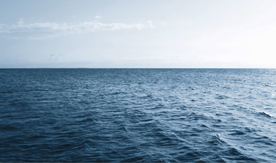
UMaine Marine Scientist Uncovers Erroneous Calculation
Pete Jumars is following the flow.
Specifically, how nonturbulent flow enters pipes, from engineered pipes to clam siphons.
And if the flow progresses how the University of Maine marine scientist thinks it will, a lot of introductory hydraulics textbooks are going to need editing.
Jumars, professor of marine sciences and oceanography in the School of Marine Sciences and at the Darling Marine Center, believes he has uncovered an erroneous scientific calculation regarding flow velocity into a pipe from a larger source of water.
He recently published results of a numerical model that he thinks gives a much more accurate answer by avoiding what he calls an unrealistic assumption in the standard engineering model.
Jumars will have an opportunity to further investigate during a 36-month $585,000 National Science Foundation-funded, UMaine-led project titled “Collaborative Research: A framework to characterize inhalant siphon flow of aquatic benthos.”
Jumars will receive $293,000 and John Crimaldi of the University of Colorado’s Department of Civil, Environmental and Architectural Engineering will get nearly $292,000 over three years to study the engineering dilemma.
Their first task is to test the predictions of Jumars’ new model under carefully controlled laboratory conditions with inanimate model systems.
“The motivation is largely that the textbook solution used up until now is clearly wrong, and we are sure that we can do better,” Jumars says.
“The clincher for me was a look at the bad fit of published experimental results to the predictions under this assumption. The assumption made no physical sense to me, and nobody could generate uniform flow across the pipe mouth (the standard assumption) in the laboratory. The experimental results look much more like my model results.”
Scientists, says Jumars, generally don’t dispose of a model until a better one is proposed. “The old ones just get patched up until somebody comes up with a better idea that explains more old results and predicts more new results,” he says.
While new ideas can meet resistance, Jumars says he doesn’t think that will be the case here even though the new model departs substantially from textbook results.
This is, in part, because of Crimaldi’s reputation as an engineer, says Jumars, and, in part, because the scientists who made the original assumption in the late 1800s and early 1900s are dead. “Reputations of living engineers are not at stake,” he says.
Using an accurate numerical model should result in a better understanding of mechanical costs of suspension feeding and the energy budgets of suspension feeders like clams overall, says Jumars.
Seawater is a very dilute food resource, and suspension feeders typically need to process a million times their body volumes of seawater each day just to make ends meet, he says.
The approaches that have been used thus far to estimate pumping costs of benthic organisms — those living on or in the bottom of a sea or lake — have been based on the flawed equation, he says.
Once the basics of the model are verified or modified in Crimaldi’s laboratory, Jumars and UMaine doctoral student Kevin du Clos will study siphon flow of benthic organisms — including thalassinid shrimp, sea squirts, soft-shelled clams, parchment worms and U-tube dwelling amphipods — as well as the oceanographic processes they drive at the DMC in Walpole, Maine. These target organisms were carefully selected to represent a range of flow speeds and animal sizes.
Jumars is betting the pumping system has evolved designs and operating procedures that limit mechanical costs and bias the system to draw water from food-rich locations above the seabed. The research project seeks to identify those designs and operating procedures for animal pumps.
To find out, they’ll explore siphon tip shape, wall thickness, height and spacing, and unsteady flow behavior and interactions with exhalent and ambient flows.
Where the water comes from that goes into the siphon is important for two reasons, Jumars says. It’s the source of food and oxygen and it’s the source of chemosensory information. What volume is the clam sensing, and whether it control where the water it sniffs comes from are questions he intends to answer.
The findings will also apply to any water-sampling device that uses a pressure difference to draw in water, Jumars says. Particles bigger than about 10 micrometers (0.0004 inches) in diameter do not faithfully follow streamlines, he says, and such particles constitute the food of suspension feeders.
Reliable sampling of suspended matter for environmental applications requires an understanding of the biases of the sampling device, Jumars says. Just as animals benefit from biases that bring them more particles, scientists benefit from eliminating biases to obtain representative samples.
Jumars says this project will improve understanding of these particle-sampling biases and how to control them.
As part of the project, staff at the Center for Ocean Sciences Education Excellence-Ocean Systems will produce webinars about siphon flows. Jumars says it’s important for the approach of the project — which combines fluid physics, mathematics and biology — to be broadly shared with high school teachers, university instructors and researchers from various backgrounds as a model of interdisciplinary research in which each discipline enhances all the others.
Contact: Beth Staples, 207.581.3777
